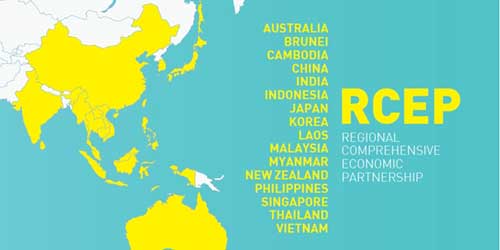
South Korea and Japan set to be the biggest winners in the Asian oil and chemicals markets as the world’s largest regional free-trade agreement paves the way for a gradual reduction in tariffs. Some analysts claim that China stands to gain most income from the pact. The China-backed agreement is seen as an alternative to the Trans-Pacific Partnership (TPP), a now-defunct U.S. trade initiative.
The Regional Comprehensive Economic Partnership (RCEP) is set to be a major boon to its participating countries, while a missed opportunity for those left out. According to the Brookings Institution, China stands to gain the most income from RCEP ($100 billion) by 2030, followed by Japan ($46 billion), South Korea ($23 billion), and Southeast Asia ($19 billion).
Being excluded from RCEP (and having withdrawn from the TPP) the U.S. will forego about $131 billion of expected come gain, while India’s decision to sit out this agreement will forego about $60 billion of income.
The trade deal allows China — by far the biggest economy and the most populous country in the region — to cast itself as the “champion of globalization and multilateral cooperation,” Gareth Leather, senior Asian economist for Capital Economics, said in a report.
The RCEP, signed last month by 15 nations accounting for around a third of the world’s population, will put Japan and South Korea, two Northeast Asian countries, in a better position to supply China’s burgeoning refining industry with a range of products. These include light-cycle oil, bitumen, base oil, aromatics, as well as petrochemical feedstocks.
China imported the equivalent of around $12 billion of these products in the first 10 months of 2020, customs data show. South Korea and Japan will likely win greater market share at the expense of the more distant Singapore and Malaysia. The Southeast nations, while also part of RCEP, already benefited from zero tariffs due to a free-trade agreement between China and ASEAN.
China’s oil-refining capacity has nearly tripled since the turn of the millennium and it could overtake the U.S. as early as next year, according to the International Energy Agency. Much of the growth is coming from massive integrated plants that produce both fuels and petrochemicals, but the refiners still need to import feedstocks such as ethylene and paraxylene.
Chinese import tariffs on oil and chemical products from South Korea and Japan, which currently range from 0.8% to 8%, will be gradually reduced to zero over the next 20 years under RCEP, according to documents posted on the website of China’s Ministry of Commerce. The Northeast Asian nations are already the biggest suppliers to China in many of the product categories, but RCEP may make them even more dominant.
The free-trade agreement is not expected to have a major impact on refined fuels, given China is already a net exporter of diesel and gasoline and does not impose any tariffs on jet fuel.
One of the oil products that might be most-affected by RCEP is light-cycle oil, used as a blending stock for diesel and fuel oil. Chinese LCO imports from Korea surged this year due to a tax loophole that exempted it from duties on refined fuels. Some shipments were even diverted via Malaysia to avoid import tariffs in China, according to traders in the market.
After eight years of negotiations, 10 Association of South East Asian (ASEAN) nations and China, Japan, South Korea, Australia, and New Zealand finalized the RCEP on November 15, bringing together about 30 percent of world’s population and gross domestic product (GDP) under the new free trade agreement. This new arrangement will compete with the European Union (EU) as the world’s largest trading bloc, and will be the most important economic configuration in Asia, totaling a 27.4% share of global trade, compared to 15 percent for the Comprehensive and Progressive Agreement for TransPacific Partnership (CPTPP).
U.S. sets to lose
China has secured a dominant position in one of the world’s most dynamic economic regions, giving Beijing the opportunity to establish its preferred rules and standards, and providing a major advantage for its companies to exploit these valuable markets. The United States, on the other hand, sets to lose out from sitting on the sidelines, as its attempts to re-shore U.S. manufacturing and promote Western-backed trade rules could be dented by the new trade agreement.
The RCEP members committed to reduce tariff rates on about 80-90 percent of the current tariff lines, to be contained in a series of bilateral tariff schedules — with carveouts for politically-sensitive agricultural sectors. By comparison, the CPTPP when fully implemented will reduce tariff rates to zero on 99 percent of tariff lines.
The RCEP will create common rules of origin for the whole bloc, so that one country-of-origin certificate will suffice in shipping goods across the membership, reducing intra-RCEP transaction costs.
To participate in the economic windfall from this new agreement, U.S. and EU companies will need to invest in production facilities within RCEP countries, potentially endangering U.S. efforts to re-shore manufacturing activity and employment back to the U.S. Many of these companies are highly reliant on production in China and will likely try to diversify their supply chains, but they will probably achieve this by moving production elsewhere in Asia instead of going back to the U.S. The big winners from this could be Southeast Asian countries, especially Vietnam.
The RCEP represents a significant strategic step forward for China — cementing trading relationships with the most populous and dynamic region of the world, whose GDP is estimated to constitute more than half of the global economy by 2050. Asian growth is increasingly driven by intra-Asian trade — already accounting for more than half of the region’s total foreign trade. With RCEP and CPTPP, the intra-Asian trade share will certainly rise further, to match the 60 percent ratio of intra-EU trade to its total trade.
China’s viable economic space
The RCEP, together with the Belt and Road Initiative (BRI), has enabled China to build out a viable economic space for itself — one where it has been influential in establishing trading rules and standards to the exclusion of the U.S. and the EU. Moreover, growing economic relationships with China stimulated by RCEP and BRI will enable China to leverage its trading, investment, and financing capabilities to compete for political influence throughout the region against the United States and the West. China’s influence can be observed in the support it receives from developing countries in international organizations and for a — in particular through their defense of China against criticisms of human right violations by the West. More importantly, China also aims to use its economic levers to gain adherents to its new technologies including 5G and 6G mobile telephony; artificial intelligence (AI) and surveillance systems; and its recently launched global positioning and navigation system Beidou as a competitor to the US-controlled GPS. This will also allow China to push its standards in these emerging technologies to be adopted by large portions of the world — helping its high-tech companies surpass its competitors in the EU and U.S.
India
Besides giving China the leg up in its competition against the United States, RCEP also raises two major issues. India’s withdrawal from the pact out of fears of sharply rising trade deficits with China and others — even though India has left the door open to participate in the future — has tilted the originally-balanced RCEP toward Chinese dominance.
A notable absentee was India, which withdrew from the RCEP negotiations last year citing concerns over opening up its agricultural and manufacturing sectors to more foreign competition.
ASEAN leaders have said they still intend to expand trade with India and that the door remains open for New Delhi to rejoin the bloc.
WTO
The RCEP has also helped deepen the fragmentation of the World Trade Organization-based global trading system, following a plethora of regional trade agreements, which have created a multitude of trading regimes and tariff schedules. This has increased the complexity and transaction costs of cross-border commerce compared with a truly global trading system, to the detriment of all countries.
The pact lowers tariffs, opens up the service sector and sets common trade rules within the bloc. The agreement covers trade, services, investment, e-commerce, telecommunications and copyright.
Chinese Premier Li Keqiang welcomed the “landmark achievement”
Japanese Prime Minister Yoshihide Suga reaffirmed his government’s support for “broadening a free and fair economic zone, including a possibility of India’s future return to the deal, and hope to gain support from the other countries.”
Vietnamese Prime Minister Nguyen Xuan Phuc expressed his satisfaction with the deal.
SIGN UP FOR COUNTERCURRENTS DAILY NEWSLETTER













































